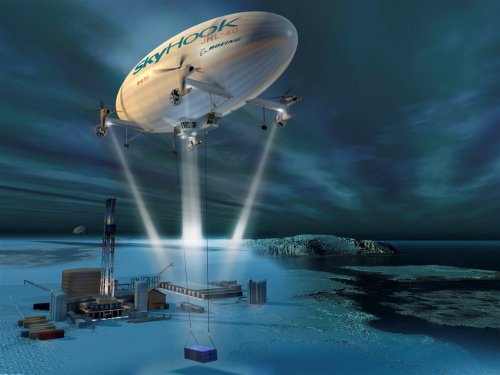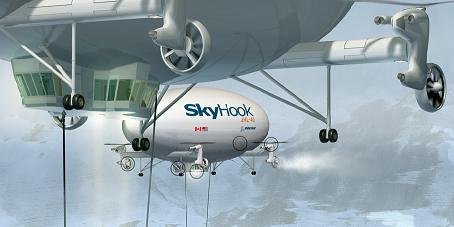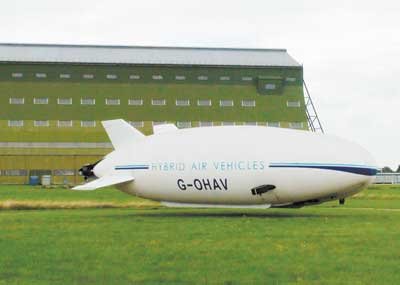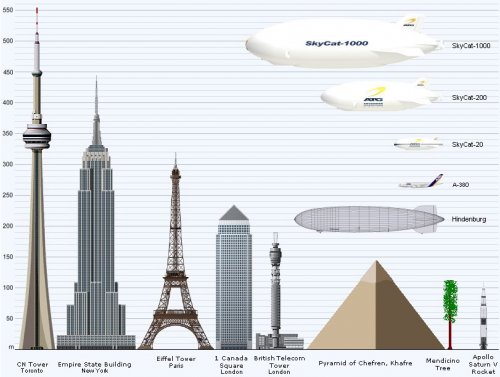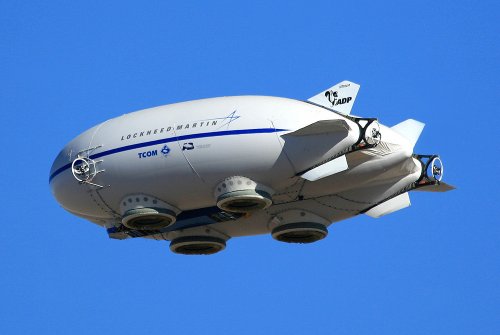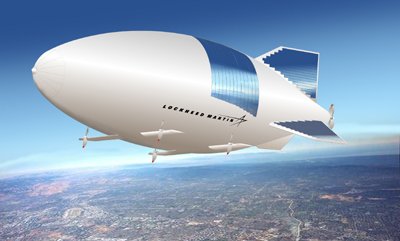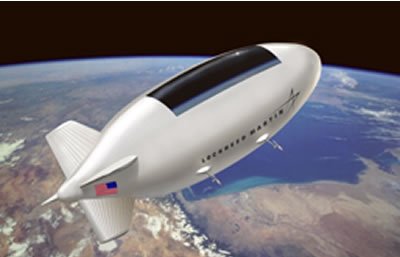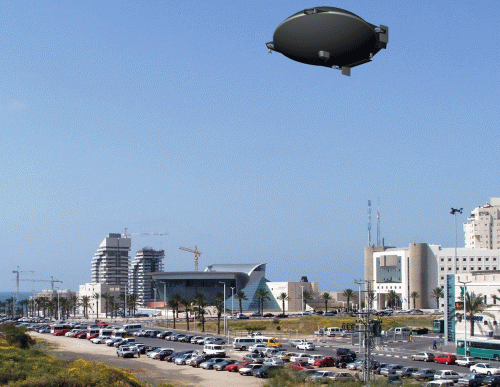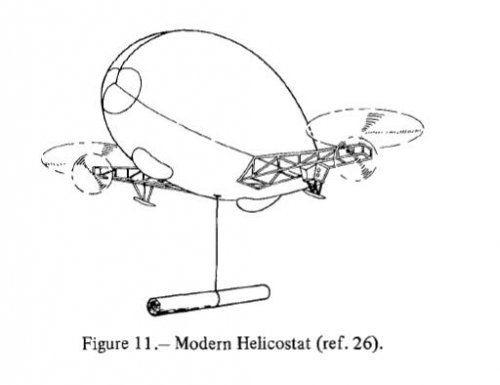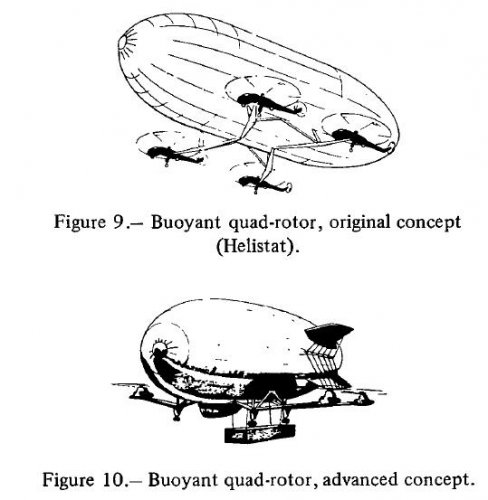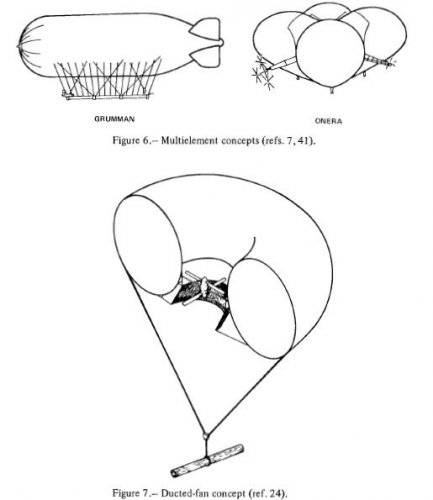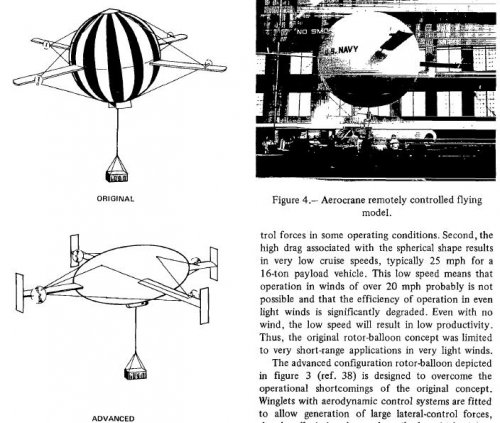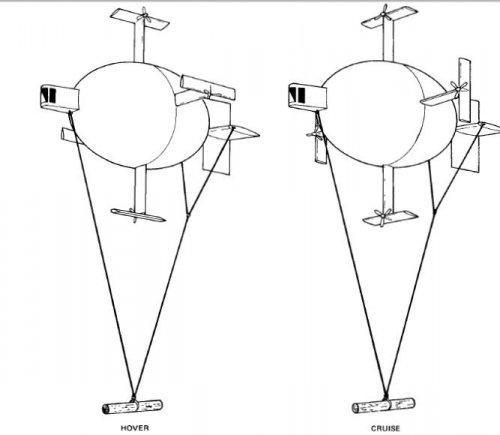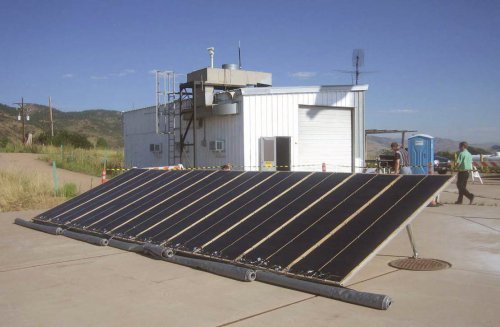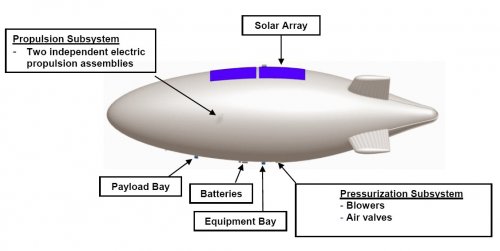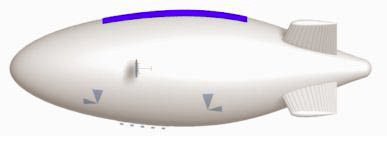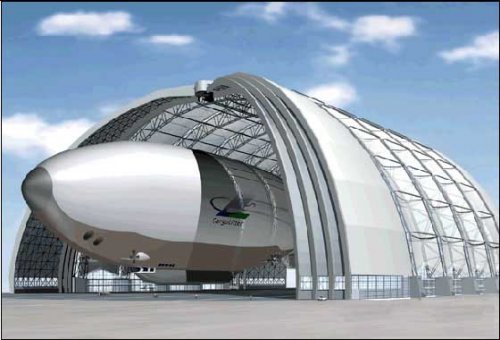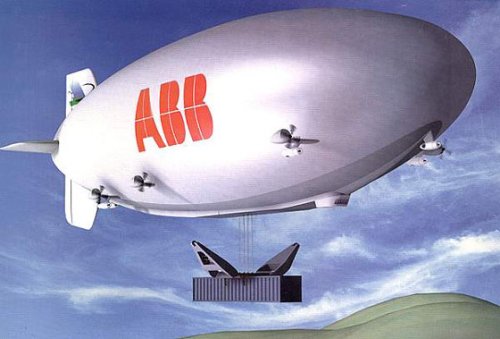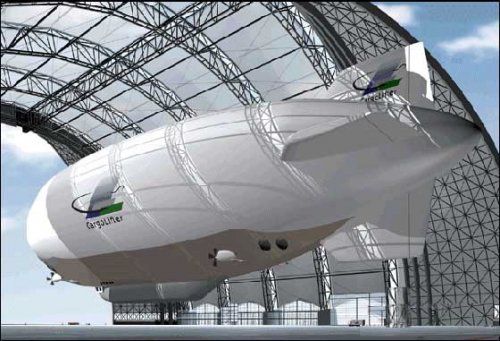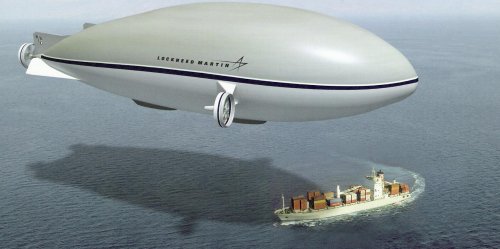You are using an out of date browser. It may not display this or other websites correctly.
You should upgrade or use an alternative browser.
You should upgrade or use an alternative browser.
Lighter-than-air and hybrid airship concepts
- Thread starter PMN1
- Start date
- Joined
- 11 March 2006
- Messages
- 8,608
- Reaction score
- 3,061
You are speaking of these SkyCats, proposed on
http://www.worldskycat.com/index.html ?
http://www.worldskycat.com/index.html ?
Attachments
The "Postwar Aircraft Projects" section of the Secret Projects forum seems to be lacking in information concerning lighter-than-air aircraft concepts such as blimps, dirigibles, airships, and hybrid airships. So I thought that I would remedy this situation by starting a topic devoted to lighter-than-air and hybrid airship concepts.
First up is the Boeing and SkyHook International JHL-40 (Jess Heavy Lifter), a commercial heavy-lift rotorcraft currently in development designed to address the limitations and expense of transporting equipment and materials in remote regions.
First up is the Boeing and SkyHook International JHL-40 (Jess Heavy Lifter), a commercial heavy-lift rotorcraft currently in development designed to address the limitations and expense of transporting equipment and materials in remote regions.
Attachments
hole in the ground
ACCESS: Secret
- Joined
- 6 August 2008
- Messages
- 232
- Reaction score
- 22
That is an interesting arrangement of props...
Aeroscraft ML866 a planned 400-ton hybrid airship, to be built by the Worldwide Aeros Corporation. A scaled-down prototype was made in 2008, and a full scale passenger craft is expected in 2010(?). It uses technology from the canceled DARPA Walrus HULA (Hybrid Ultra Large Aircraft/airship) airship.
http://www.aeroscraft.com/
http://www.youtube.com/watch?v=JHRzqlKGZyE
http://www.aeroscraft.com/
http://www.youtube.com/watch?v=JHRzqlKGZyE
Attachments
-
 20090318_394290.jpg49.2 KB · Views: 237
20090318_394290.jpg49.2 KB · Views: 237 -
 Aeroscraft%20at%20NBAA.jpg43.4 KB · Views: 154
Aeroscraft%20at%20NBAA.jpg43.4 KB · Views: 154 -
 download.jpg48.8 KB · Views: 153
download.jpg48.8 KB · Views: 153 -
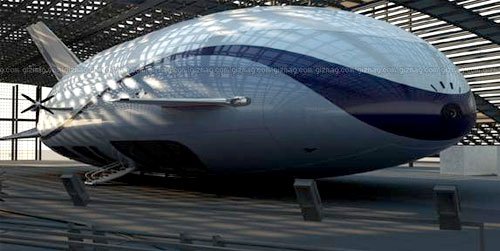 aeroscraft866_newtechupdate.jpg33.7 KB · Views: 168
aeroscraft866_newtechupdate.jpg33.7 KB · Views: 168 -
 vliegtuig-van-de-toekomst-ml866-aeroscraft4.jpg80.4 KB · Views: 151
vliegtuig-van-de-toekomst-ml866-aeroscraft4.jpg80.4 KB · Views: 151 -
 9130_8040844949_14.jpg14.8 KB · Views: 153
9130_8040844949_14.jpg14.8 KB · Views: 153 -
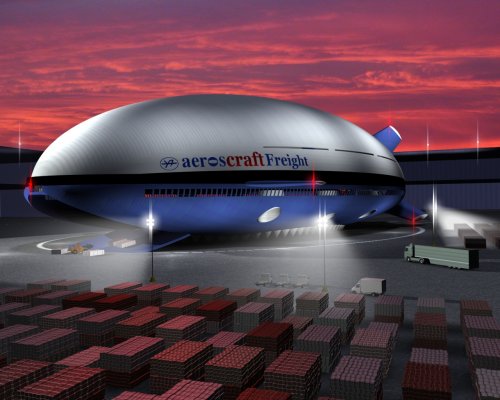 aeroscraft_cargo.jpg858.5 KB · Views: 153
aeroscraft_cargo.jpg858.5 KB · Views: 153 -
 aeroscraft_ML866.jpg315.4 KB · Views: 153
aeroscraft_ML866.jpg315.4 KB · Views: 153
Advanced Technology Group (ATG), now World SkyCat Ltd., SkyCat. SkyCat (a portmanteau of "Sky Catamaran") is a class of proposed heavy-lift and ultra-heavy-lift hybrid aircraft which derive more than half of their lift by Helium buoyancy and the balance via aerodynamic lift produced by aerodynamic shaping. Such vehicles are not "payload specific". Because the SkyCat designs incorporate hover cushion technology in place of wheels, they can take-off and land anywhere, including remote regions without need for airports or sophisticated forward based infrastructure.
The SkyKitten, a 1/6 linear scale model of a SkyCat design was built and flown by ATG in the United Kingdom at Cardington.
SkyCat consists of the following models:
SkyCat 20
SkyCat 200
SkyCat 1000
http://en.wikipedia.org/wiki/SkyCat
http://www.worldskycat.com/
http://www.aerospace-technology.com/projects/skycat/
The SkyKitten, a 1/6 linear scale model of a SkyCat design was built and flown by ATG in the United Kingdom at Cardington.
SkyCat consists of the following models:
SkyCat 20
- Length 81m
- Width 41m
- Height 24m
- Total volume 32,000m³
- Maximum payload 20,000kg
- Payload deck length 22.3m
- Payload deck width 3m
- Payload deck height 2m
- Cruise speed 130km/h
- Maximum operating speed 148km/h
- Range with maximum payload 2,268km
- Ferry range 7,408km
- Altitude ceiling 2,745m
SkyCat 200
- Length 185m
- Width 77m
- Height 47m
- Total volume 4,557,500m³
- Maximum payload 200,000 kg
- Payload deck length 49m
- Payload deck width 7.5m
- Payload deck height 5m
- Cruise speed 139km/h
- Maximum operating speed 166km/h
- Range 5,970km
- Altitude ceiling 2,745m
SkyCat 1000
- Length 307m
- Width 136m
- Height 77m
- Total volume 2 million m³
- Maximum payload 1 million kg
- Payload deck length 81m
- Payload deck width 12.2m
- Payload deck height 8m
- Cruise speed 185km/h
- Maximum operating speed 203km/h
- Range 7,400km
- Altitude ceiling 2,745m
http://en.wikipedia.org/wiki/SkyCat
http://www.worldskycat.com/
http://www.aerospace-technology.com/projects/skycat/
Attachments
The Lockheed Martin P-791 is an experimental aerostatic/aerodynamic hybrid airship. The first flight of the P-791 was made on 31 January 2006 at the company's flight test facility on the Palmdale Air Force Plant 42. The reason for the construction of the P-791 is unknown but some observers believe that it might have been developed as part of the DARPA Walrus HULA project.
http://en.wikipedia.org/wiki/P-791
http://www.secretprojects.co.uk/forum/index.php/topic,2908.0.html
http://en.wikipedia.org/wiki/P-791
http://www.secretprojects.co.uk/forum/index.php/topic,2908.0.html
Attachments
The Lockheed Martin High Altitude Airship (HAA) is an un-tethered, unmanned lighter-than-air vehicle, that will operate above the jet stream in a geostationary position to deliver persistent station keeping as a surveillance platform, telecommunications relay, or a weather observer. The HAA also provides the Warfighter affordable, ever-present Intelligence, Surveillance and Reconnaissance and rapid communications connectivity over the entire battle space.
http://en.wikipedia.org/wiki/High-altitude_airship
http://www.lockheedmartin.com/products/HighAltitudeAirship/index.html
http://en.wikipedia.org/wiki/High-altitude_airship
http://www.lockheedmartin.com/products/HighAltitudeAirship/index.html
Attachments
- Joined
- 4 May 2008
- Messages
- 2,440
- Reaction score
- 675
Triton said:The Lockheed Martin P-791 is an experimental aerostatic/aerodynamic hybrid airship. The first flight of the P-791 was made on 31 January 2006 at the company's flight test facility on the Palmdale Air Force Plant 42. The reason for the construction of the P-791 is unknown but some observers believe that it might have been developed as part of the DARPA Walrus HULA project.
It bears striking resemblance with the now defunct PERSIUS. New efforts along the same lines continue under program LEMV (Long Endurance Multi-INT Vehicle)
more info here:
http://www.aviationweek.com/aw/blogs/defense/index.jsp?plckController=Blog&plckScript=blogScript&plckElementId=blogDest&plckBlogPage=BlogViewPost&plckPostId=Blog:27ec4a53-dcc8-42d0-bd3a-01329aef79a7Post:3c0ec60a-4bb5-43d4-b0ff-fefdf0733cb6
Attachments
Hammer Birchgrove
ACCESS: Top Secret
- Joined
- 13 May 2009
- Messages
- 583
- Reaction score
- 36
Why is there such a seemingly big resistance to airships used as airliners? They're safer, more flexible, VTOL (sort of)... Lack of speed (which can be addressed with metal skin and jets) and Hindenburg (happened decades ago) can't be the only reasons?
- Joined
- 4 May 2008
- Messages
- 2,440
- Reaction score
- 675
Well, so far all manned airships have been limited to about 10,000 feet cruise altitude (some Zeppelins flew higher during WW I). I guess you could pressurize a gondola and fly higher, but then statistically you find higher windspeeds, which are very bad for airships. In a head wind, you might end up flying at 20 knots ground speed. The real advantage of blimps is station keeping in very light winds, where you have very long endurance because it takes very little power to stay aloft. Increase the required airspeed, and fixed-wing starts looking better.
The aerodynamics of airships tend to favor very large aircraft, because the friction coefficient goes down.
For large airships the problem of airport compatibility arises. Ground handling is also an issue. P-791 has the advantage of being able to use the fans at the bottom of the envelope as suction cups to pin itself to the ground or to help steer while taxiing. It is also of hybrid design, so the buoyancy is less than the weight. In order to fly, it needs some forward velocity, just like for fixed wings. This means that while on the ground, it's less likely to float around.
The aerodynamics of airships tend to favor very large aircraft, because the friction coefficient goes down.
For large airships the problem of airport compatibility arises. Ground handling is also an issue. P-791 has the advantage of being able to use the fans at the bottom of the envelope as suction cups to pin itself to the ground or to help steer while taxiing. It is also of hybrid design, so the buoyancy is less than the weight. In order to fly, it needs some forward velocity, just like for fixed wings. This means that while on the ground, it's less likely to float around.
- Joined
- 17 October 2006
- Messages
- 2,282
- Reaction score
- 607
Pressurizing an airship cabin always seems contrary to the intention of the entire exercise, but maybe that's just my opinion.
Hammer Birchgrove
ACCESS: Top Secret
- Joined
- 13 May 2009
- Messages
- 583
- Reaction score
- 36
Thanks.
- Joined
- 18 March 2008
- Messages
- 3,532
- Reaction score
- 724
AeroFranz said:Well, so far all manned airships have been limited to about 10,000 feet cruise altitude (some Zeppelins flew higher during WW I). I guess you could pressurize a gondola and fly higher, but then statistically you find higher windspeeds, which are very bad for airships.
The big problem for airships and altitude is lift not wind speed. As the atmosphere gets thinner the realtive lift of the lighter-than-air gas reduces. So in order for Zeppelins and others to fly high they have to sacrifice payload that they could carry in the thick air of low altitudes. Of course you could design your LTA for the lower lift levels of high altitude like the Lockheed BMD LTA but your gas envelope to payload margin is significantly increased.
fanstream
ACCESS: Restricted
- Joined
- 3 October 2008
- Messages
- 11
- Reaction score
- 1
airship "Sky Wanderer" SW-60000
Length 120m
Width 30m
Height 38m
Total volume 60 000 m³
Maximum payload 10000 kg
Payload deck length 30m
Payload deck width 3m
Payload deck height 6m
Cruise speed 100km/h
Maximum operating speed 120km/h
Range 4,500km (8,000km)
Altitude ceiling 2,000m
http://aero.moy.su/index/0-8
http://aero.moy.su/photo/3-0-22
Length 120m
Width 30m
Height 38m
Total volume 60 000 m³
Maximum payload 10000 kg
Payload deck length 30m
Payload deck width 3m
Payload deck height 6m
Cruise speed 100km/h
Maximum operating speed 120km/h
Range 4,500km (8,000km)
Altitude ceiling 2,000m
http://aero.moy.su/index/0-8
http://aero.moy.su/photo/3-0-22
Attachments
- Joined
- 4 May 2008
- Messages
- 2,440
- Reaction score
- 675
They are. There are fans that can be used to pin the vehicle to the ground. Makes ground taxiing easier. I think they can also lift up on takeoff. Remember, the -791 is a hybrid, so it needs forward airspeed or vectored thrust to sustain flight.
- Joined
- 26 May 2006
- Messages
- 32,688
- Reaction score
- 11,912
- Joined
- 4 May 2008
- Messages
- 2,440
- Reaction score
- 675
Lockheed unveils HALE-D airship
form ARES blog
http://www.aviationweek.com/aw/blogs/defense/index.jsp?plckController=Blog&plckBlogPage=BlogViewPost&newspaperUserId=27ec4a53-dcc8-42d0-bd3a-01329aef79a7&plckPostId=Blog%3a27ec4a53-dcc8-42d0-bd3a-01329aef79a7Post%3aa83618ef-26f2-4630-b0b4-e176a1fb5681&plckScript=blogScript&plckElementId=blogDest
form ARES blog
http://www.aviationweek.com/aw/blogs/defense/index.jsp?plckController=Blog&plckBlogPage=BlogViewPost&newspaperUserId=27ec4a53-dcc8-42d0-bd3a-01329aef79a7&plckPostId=Blog%3a27ec4a53-dcc8-42d0-bd3a-01329aef79a7Post%3aa83618ef-26f2-4630-b0b4-e176a1fb5681&plckScript=blogScript&plckElementId=blogDest
Attachments
Is it just me or does it really look like it has the shape proposed by Goldschmied for wake propulsion?AeroFranz said:Lockheed unveils HALE-D airship
John21
ACCESS: Confidential
- Joined
- 27 May 2007
- Messages
- 150
- Reaction score
- 11
I wanted to post this since it is also an airship and it could see use pretty soon.
http://www.aviationweek.com/aw/blogs/defense/index.jsp?plckController=Blog&plckBlogPage=BlogViewPost&newspaperUserId=27ec4a53-dcc8-42d0-bd3a-01329aef79a7&plckPostId=Blog%3a27ec4a53-dcc8-42d0-bd3a-01329aef79a7Post%3af2996a4f-f738-4cb2-8157-afba2eb5ca28&plckScript=blogScript&plckElementId=blogDest

I hope it works out in the end, although it would be pretty vulnerable in any conventional type of warfare. At 20,000+ feet it would be out of range of anything insurgents can get their hands on, at least for now. I do like the "optionally manned" part. B)
http://www.aviationweek.com/aw/blogs/defense/index.jsp?plckController=Blog&plckBlogPage=BlogViewPost&newspaperUserId=27ec4a53-dcc8-42d0-bd3a-01329aef79a7&plckPostId=Blog%3a27ec4a53-dcc8-42d0-bd3a-01329aef79a7Post%3af2996a4f-f738-4cb2-8157-afba2eb5ca28&plckScript=blogScript&plckElementId=blogDest

I hope it works out in the end, although it would be pretty vulnerable in any conventional type of warfare. At 20,000+ feet it would be out of range of anything insurgents can get their hands on, at least for now. I do like the "optionally manned" part. B)
Avimimus
ACCESS: Top Secret
- Joined
- 15 December 2007
- Messages
- 2,234
- Reaction score
- 499
I've often wondered what would happen if you placed a metal mesh underneath an airship. It might still remain vulnerable to high calibre/high velocity artillery, but it would temporarily negate the effectiveness of most missiles (until ones are developed with two stage warheads at least).
- Joined
- 4 May 2008
- Messages
- 2,440
- Reaction score
- 675
Simon666 said:Is it just me or does it really look like it has the shape proposed by Goldschmied for wake propulsion?
I hadn't thought about it, but that could certainly be the case, especially since I can't tell where the propulsion pack is in that picture. That leaves the tail as a likely position.
Of course, it could also just be that the gondola hasn't been attached yet under the belly, and that the perspective is misleading, but you might be onto something!
- Joined
- 1 April 2006
- Messages
- 10,729
- Reaction score
- 6,753
HALE-D
Hull Volume 500,000 ft3
Diameter 70 ft
Length 240 ft
Cruise Speed 20 ktas @ 60 kft
Solar Array 15 kW thin film
Sea Level Gross Weight 3000 lbs
Energy Storage 40 kWh Li-Ion Battery
Propulsion Motors 2 kW Electric
images (c) Lockheed Martin Corp.
Hull Volume 500,000 ft3
Diameter 70 ft
Length 240 ft
Cruise Speed 20 ktas @ 60 kft
Solar Array 15 kW thin film
Sea Level Gross Weight 3000 lbs
Energy Storage 40 kWh Li-Ion Battery
Propulsion Motors 2 kW Electric
images (c) Lockheed Martin Corp.
Attachments
fanstream
ACCESS: Restricted
- Joined
- 3 October 2008
- Messages
- 11
- Reaction score
- 1
GALA-30, GALA-100 hybrid airship concept RosAeroSystems
http://www.rosaerosystems.pbo.ru/russian/products/pd_300.html
http://www.aviationtoday.ru/news8410.html
http://www.mioge.ru/downloads/pdf/2008/RosAeroSystems.pdf
http://www.rosaerosystems.pbo.ru/russian/products/pd_300.html
http://www.aviationtoday.ru/news8410.html
http://www.mioge.ru/downloads/pdf/2008/RosAeroSystems.pdf
- Joined
- 8 January 2006
- Messages
- 1,605
- Reaction score
- 677
ISTR reading studies, including AIAA papers some 35 or so years ago on nuclear-powered rigid airships (two turbofans and one huge turborprop using helicopter rotors as blades). Apparently the idea attracted enough interest to show up in a mid-1970s technothriller, Clash fo Titans (not to be at all confused with a movie, or novelizatin thereof, of similar name that came out about that time). Novel was a good read, an American nuclear-powered rigid airship going against a Soviet vstol carrier to salvage secret material aboartd an airliner that crasned on a Pacific island.
- Joined
- 18 March 2008
- Messages
- 3,532
- Reaction score
- 724
Avimimus said:I've often wondered what would happen if you placed a metal mesh underneath an airship. It might still remain vulnerable to high calibre/high velocity artillery, but it would temporarily negate the effectiveness of most missiles (until ones are developed with two stage warheads at least).
The metal mesh would do nothing. Most anti-air missiles are designed to explode in proximity to the target and any armour layer – mesh or solid – would need to be very strong and weighty to stop enough high velocity fragments to make any difference.
Part of the SkyCat trails - back when they were funded - included vulnerability and they found that the helium inflated design was effectively invulnerable to 60mm mortar fires.
http://www.worldskycat.com/skycat/safety.html
Artist's impression of CargoLifter AG CL 160 Super Heavy-Lift Cargo Airship.
Source:
http://www.aerospace-technology.com/projects/cargolifter/
http://www.zukunft-in-brand.de/index.php?id=216&L=1
Source:
http://www.aerospace-technology.com/projects/cargolifter/
http://www.zukunft-in-brand.de/index.php?id=216&L=1
Attachments
Artist's impression of Lockheed Martin Semi-Buoyant Aircraft.
Source:
http://www.combatreform.org/airborneaircraftcarriers.htm
Source:
http://www.combatreform.org/airborneaircraftcarriers.htm
Attachments
Artist's impression of Skyhook HLV concept with previous Skyhook Boeing JHL-40 concept.
Source: http://www.flickr.com/photos/lazzo13/4827463712/
Source: http://www.flickr.com/photos/lazzo13/4827463712/
Attachments
Lockheed Highspot (Hi-Spot?) program flier found on eBay.
URL: http://cgi.ebay.com/LOCKHEED-HIGHSPOT-DATA-FLIER-/220662352756?pt=LH_DefaultDomain_0&hash=item3360804b74
Description:
URL: http://cgi.ebay.com/LOCKHEED-HIGHSPOT-DATA-FLIER-/220662352756?pt=LH_DefaultDomain_0&hash=item3360804b74
Description:
Aerospace companies typically produce program fliers for distribution to potential customers at trade shows. These fliers include a photo or artist concept of the program with key details on the reverse side. This 11 X 14 inch data flier describes the HIGHSPOT program from the early 1980’s, a high altitude blimp technology predecessor to the modern RPV. It is in very good condition. I will be shipped rolled.
Attachments
- Joined
- 25 June 2009
- Messages
- 13,781
- Reaction score
- 3,060
Is the humanitarian aspect a genuine goal, or merely an alibi to develop the technology for military purposes?
Source: USTRANSCOM Support to Foreign Humanitarian Assistance
Source: USTRANSCOM Support to Foreign Humanitarian Assistance
Attachments
S
sublight
Guest
Are there any specifically mid eighties Boeing design studies?
- Joined
- 3 June 2006
- Messages
- 2,842
- Reaction score
- 2,544
http://www.youtube.com/watch?v=x2mYxoPGghA
Source: LockheedMartinVideosThe U.S. Army and Lockheed Martin launched the first-of-its kind High Altitude Long Endurance-Demonstrator July 27, 2011, from the historic Akron Airdock.
- Joined
- 9 October 2009
- Messages
- 19,968
- Reaction score
- 10,457
A bit of a setback for HALE-D: http://seattletimes.nwsource.com/html/nationworld/2015742309_apusunmannedblimpcrash.html
Similar threads
-
-
Lockheed Martin LMH-1 heavy-lift hybrid airship
- Started by Triton
- Replies: 5
-
-
Goodyear "Dynastat" giant transport projects
- Started by Stargazer
- Replies: 2
-
JP Aerospace, three airships (and electric propulsion) to orbit?
- Started by FutureSpaceTourist
- Replies: 30



